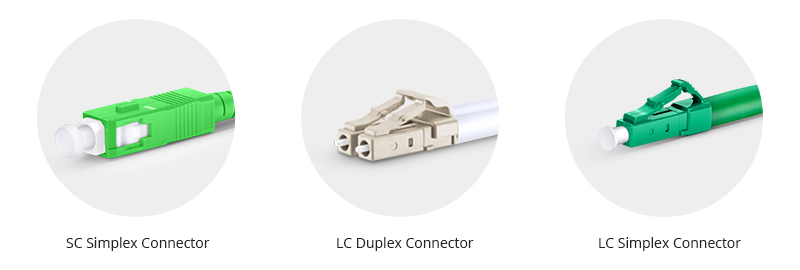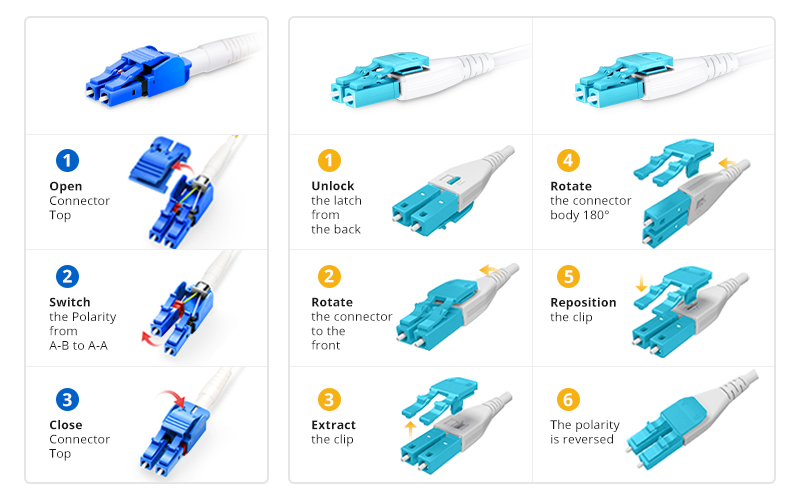LC Fiber Optics: A Comprehensive Guide
LC fiber connectors, as the most well-known representative of SFF (Small Form Factor) connector, are widely adopted in today’s LAN and data center cabling. You may find LC connector has a strong family which includes but not limited to LC optical fiber connectors, LC fiber patch cables, LC fiber adapters, LC patch panels, and other LC fiber assemblies. How many LC-interfaced products are there in fiber optics on Earth? This paper is going to explore the world of LC solutions.
What Does LC Mean in Fiber Optics?
LC stands for a type of optical connector of which the full name is Lucent Connector. It comes with the name because the LC connector was first developed by Lucent Technologies (Alcatel-Lucent for now) for telecommunication applications. It uses a retaining tab mechanism and the connector body resembles the squarish shape of the SC connector, but LC's size is only half of SC's, making it more suitable for high-density connection. Like the SC type connector, the LC fiber optic connector is easy to plug in or remove, providing a secure, precisely aligned fit conforming to TIA/EIA 604 standards. Until now, it is still one of the most popular fiber optic connectors in the fiber optic market.

Figure 1: LC/SC fiber connector
What Does LC Connector Feature?
So what features does an LC connector have to keep itself maintain in the marketplace? Owing to the different applications and manufacturers’ preference, not all the LC connectors are created the same. However, there are still some general features that LC connectors have:
-
Small form factor:LC connector is half the dimension of regular connectors such as SC, FC, and ST connectors. The compact and fool-proof design enables LC connectors to be deployed in high-density applications.
-
Low insertion loss performance: The LC connector has a six-position tuning feature to achieve very low insertion loss performance by optimizing the alignment of the fiber cores.
-
Versatility in Assembly: LC connectors can be supplied as a pre-assembled one-piece connector or as a multi-piece connector. The pre-assembled connector is able to reduce assembly time for on-site installation while the multi-piece connector is more suitable for factory assembly.
What Are LC Fiber Optic Solutions?
There have been many LC fiber optic solutions: LC fiber connectors, LC fiber patch cables, LC fiber adapters, LC fiber patch panels, LC fiber attenuators and so on, each available for multiple needs in applications such as telecommunications networks, LANs, etc.
LC Fiber Connector Solution
Generally, there are two versions of LC connectors: fiber patch cable connector and behind-the-wall (BTW) connector.
LC Connectors for Jumpers
There are two types of LC connectors for jumpers. LC 1.5 to 2.0mm connectors are designed to mount onto 1.5 to 2.0mm fiber cordage. While LC 3.0mm connectors are designed to mount on 3.0mm cordage. Simplex and duplex fibers are both available for the connectors. The following image shows the two LC connectors with different core diameters.

Figure 2: LC 2.0mm/3.0mm connector
LC BTW Connectors
The BTW connector is a shorter version of LC designed for 0.9mm buffered fiber. Typically, it is utilized on the back side of the equipment. There is one type of LC BTW connector which is based on the unibody connector—LC BTW unibody connector.
LC Fiber Patch Cable Solution
Standard LC Fiber Patch Cable
LC-LC fiber patch cable with two LC fiber connectors terminated at both ends is the most commonly used fiber optic cable type in the industry. Compared to other conventional connectors like SC fiber cables, LC fiber cables are known for their compact form factor and stable performance. Therefore, LC fiber cables remain a popular choice for many applications. Standard LC fiber patch cables can be divided into single mode (OS1/OS2), multimode (OM1/OM2/OM3/OM4/OM5), duplex, and simplex fiber cable types.
Uniboot LC Fiber Patch Cable
To cope with the “high density” trend in data centers, uniboot LC fiber cable is born. From the picture below, we can clearly see the differences between a uniboot LC fiber patch cable (right) and a standard LC cable (left).

Figure 3: Uniboot LC cable vs standard LC cable
Uniboot LC patch cord has two LC fiber connectors encased in a common housing with only one boot terminated on a single twin-fiber round cable, which can cut down the cable count up to 50% compared with the traditional LC duplex patch cord. What’s more, uniboot LC fiber patch cord with push-pull tab has been proved that it can further increase cabling density up to 50%.
Note: There are many different versions of uniboot LC-LC patch cables. The polarity reversal of them might be different from each other. Two most commonly used versions of uniboot LC patch cords polarity reversal steps are shown in the picture below.

Figure 4: LC patch cord polarity reversal steps
Ultra Low Loss LC Fiber Patch Cable
Ultra low loss LC fiber optic cable is one of the highest performance fiber patch cables, featuring a rugged single-piece body connector with a latch trigger up to 4x stronger than standard connectors. Standard LC fiber cables maintain an insertion loss of 0.3 dB, while ultra low loss LC fiber cables produce an insertion loss of only 0.12 dB, providing exceptional performance and lower power consumption. This fiber cable type typically has a Grade B connector ensuring ultra low IL and RL and avoiding the production of error code and worse signal. Ultra low loss LC fiber optic cable is available in single mode and multimode cable types.
Armored LC Fiber Patch Cable
Armored LC fiber patch cables keep the similar feature as standard LC fiber patch cord. But compared with standard LC fiber patch cords, they are made of armored fiber optic cables and are stronger and more robust so as to protect the cable from rodent bite, pressure, or twist. Though they are more robust than standard cables, they are actually as flexible as the standard ones and hard to break when they are bent. Besides, the outer diameter of armored LC fiber patch cable is similar to a standard LC fiber patch cable, thus it saves much space.
Mode-Conditioning LC Patch Cable
Mode-conditioning LC patch cables combine multimode fiber cable and single mode fiber cable with calibration. They are built in the form of the general duplex LC patch cables, making it convenient to install cables without the need for other additional assemblies. It is designed for long wavelength Gigabit Ethernet applications. For some occasions that standard multimode LC patch cord can not be directly plugged into some 1G/10G optical modules, mode-conditioning LC patch cables will eliminate this issue, saving the cost of upgrading fiber plant for customers. The commonly used mode-conditioning LC patch cables include LC to LC connector, LC to SC connector, and LC to FC connector with multimode fiber optic cables.

Figure 5: LC-LC mode-conditioning patch cord
LC/MTP®/MPO/SC/FC/ST-LC Breakout Fiber Patch Cable
Breakout cable, or called fall-out cable contains several fibers, each with their own jacket, and then encased by a single common jacket. The fiber counts vary from 2 to 24 fibers. There are two cases for LC breakout cable. One is that breakout fiber patch cable has the same connectors on each end, which means both the ends are LC connectors. For the other case, there are different connectors on each end of the fiber. One end is LC and the other can be MTP®, MPO, ST, FC, etc. Breakout fiber patch cables are widely applied for telecommunication networks, data center communications, etc., providing you with the advantage of multiple connectors without having to change the entire system.
LC Fiber Adapter & Patch Panel Solutions
Fiber optic adapters or fiber couplers are designed to connect two fiber patch cables together. LC fiber adapter features a self-adjusting mechanism designed to accommodate patch panels of thickness between 1.55 to 1.75 mm. It is available in single mode, multimode, simplex and duplex options. LC simplex adapter connects one LC connector pair in one module space. While LC duplex adapter connects two LC connector pairs in one module space.
Fiber patch panels are also known as fiber distribution panels. The rack size can be 1U,2U, etc. 1U is the most commonly used rack size in data centers. The number of ports on a fiber optic patch panel is actually not limited, they can vary from 12, 24, 48,64,72, and even more. Both LC fiber adapter and LC fiber patch panels are ideal for high-density fiber cabling. LC fiber patch panel can be pre-loaded or unloaded with LC fiber adapters for both single mode and multimode fiber, providing a flexible and easy way for the server room, data center, and other high-density fiber installations.

Figure 6: LC fiber adapter panels and adapters
LC Fiber Attenuator Solution
LC fiber attenuators are another commonly used LC devices. An LC optical attenuator is a passive device used to reduce the power level of an optical signal in the optical network where erbium-doped amplifiers are being used. There are fixed and variable LC fiber attenuators available in different attenuation level as shown in the figure below. For example, an LC 1dB fiber attenuator means this optical attenuator uses an LC fiber connector and it can reduce the fiber power level by 1dB. For more detailed information about fiber attenuator, please visit Guideline for Fixed Fiber Optic Attenuator.

Figure 7: LC variable fiber attenuator and fixed fiber attenuator
Other LC-Interfaced Product Solutions
MTP®/MPO to LC Fiber Cassette
MTP®/MPO to LC Fiber Cassettes are pre-terminated modular modules that need to be installed on a fiber rack mount. An MTP®/MPO to LC cassette has LC adapters on the front side and MTP®/MPO at the rear. The LC interfaces on the front side can be connected with devices via LC patch cords and the MTP® interface at the rear can be plugged with MTP® cable so as to provide secure transition between MTP® and LC connectors.
LC-Interfaced Transceiver Module
LC-interfaced transceiver modules are the modules that use LC interface type so that they can be linked with LC fiber patch cables. These LC transceiver modules include many types: most SFP optical transceivers, 10G SFP+ optical transceivers, 25G SFP28 optical transceivers, and some 40G QSFP+ optical transceivers, 100G QSFP28 optical transceiver, and 400GBASE-FR4 and 400GBASE-LR8 in 400G QSFP-DD transceivers. The LC connector type these transceiver modules are equipped are either simplex or duplex based on different standards.
LC Fiber Media Converter
There are two types of media converter: copper to fiber media converter, which achieves the conversion of copper and fiber cables, and fiber to fiber media converter, which enables fiber patch cable to realize the multimode to single mode fiber conversion and dual fiber to single fiber conversion. The interface types of fiber media converter are various, such as LC, ST, SC, MT-RJ, RJ45. Fiber media converters with the LC interface can be connected to the target devices directly with the use of LC fiber patch cables.
Conclusion
LC is a common standard and interface type in fiber optics, known for its compact and reliable features, making it particularly popular in high-density cabling and high-performance networks. LC fiber optic solutions encompass a wide range of types and applications, including LC connectors, fiber patch cables, adapters and patch panels, fiber attenuators, and other interfaced products like MTP®/MPO to LC fiber cassettes, LC-interfaced transceiver modules, and fiber media converters. These solutions provide efficient and stable fiber connections, meeting the requirements of various network scenarios and enhancing network performance and reliability.
You might be interested in
Email Address

-
PoE vs PoE+ vs PoE++ Switch: How to Choose?
May 30, 2024













